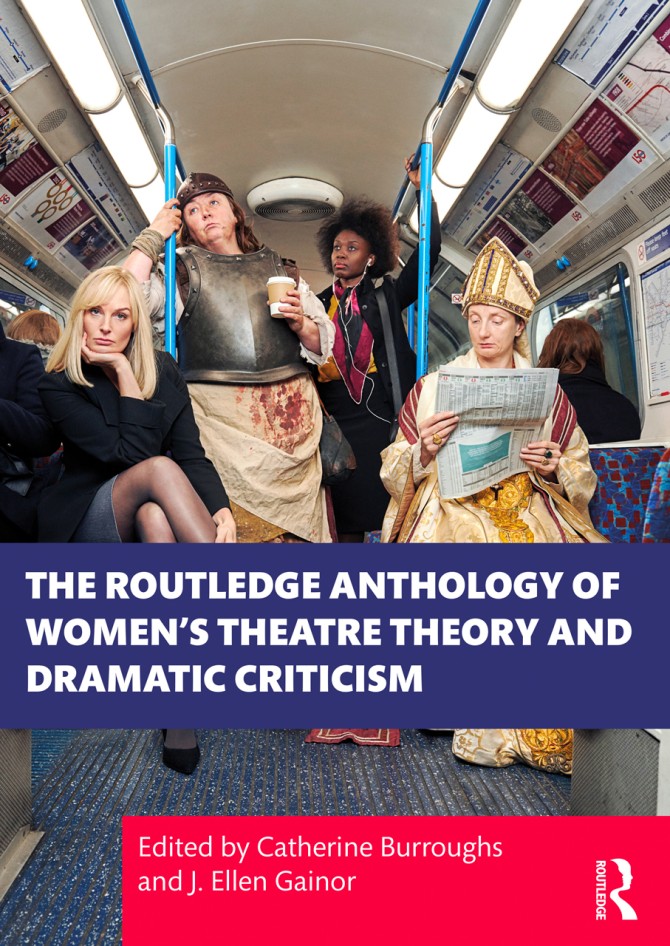Scholars spearhead anthology of women’s theater writing
By Kate Blackwood
In a letter, in a poem, in an unpublished speech – key primary documents on theater by women writers do not always appear in conventional places, and scholars have claimed even recently that few women theorists existed before the 20th century, according to scholar J. Ellen Gainor.
Yet women have been writing critically about theater and drama for hundreds of years.
“Through my editing work for the ‘Norton Anthology of Drama’ and my scholarship on and teaching of women playwrights, I was aware of how few women writers of dramatic theory or criticism were considered part of the ‘canon,’” said Gainor, professor of performing and media arts in the College of Arts and Sciences (A&S).
To fill this gap, Gainor and Catherine Burroughs, courtesy professor in literatures in English and performing and media arts (A&S), have edited “The Routledge Anthology of Women’s Theatre Theory and Dramatic Criticism,” the first wide-ranging anthology of theater theory and dramatic criticism by women and woman-identified writers. With entries by more than 80 scholars, including Cornell faculty and alumni, the collection contains important primary documents accompanied by short essays.
“The collection underscores the simple fact that women have a long history of producing theory and criticism, although it may not have always been apparent as such, nor has it been embraced within the discipline’s traditional narratives,” Burroughs and Gainor wrote in the anthology’s introduction. “Women authors may have used alternative genres, sometimes without a public aim, to express themselves, including letters, diaries, marginalia, prefaces, epilogues, scrapbooks, or other creative forms.”
The collection unearths archived or neglected writings and expands the concept of a theoretical and critical tradition, resulting in a body of work “that can be read directly in dialogue with, and at times in opposition to, the male critical tradition that has heretofore defined the field,” Burroughs and Gainor wrote.
Entries are arranged chronologically, beginning with two chapters by Andrew Galloway, the James John Professor of Medieval Studies in literatures in English (A&S), covering five medieval women (ranging from St. Perpetua, c. 185-203, to Margery Kempe, c. 1373-1438) and Hrotsvit of Gandersheim (c. 935-1002).
Burroughs contributed an entry on actor, playwright, poet and diarist Frances Anne Kemble (1809-1893). A member of a prominent British theater family, Kemble was nonetheless “very harsh” in her theoretical work, Burroughs wrote, on the profession into which she had been born.
Nick Salvato, professor of performing and media arts (A&S), wrote the anthology’s entry on playwright and novelist Djuna Barnes, including her 1917 journalistic piece, “When the Puppets Come to Town.”
Aoise Stratford, lecturer in performing and media arts (A&S) and an advising dean in the college, contributed an entry on Dorothy Hewett, one of the most significant Australian playwrights of the 20th century, excerpting “Why Does Sally Bow?”, Hewett’s 1977 essay discussing her play, “The Chapel Perilous.” Stratford also contributed an entry on renowned Scottish writer Liz Lochhead, including parts of the introduction Lochhead wrote for her 1987 play, “Mary Queen of Scots Got Her Head Chopped Off.”
Sara Warner, associate professor of performing and media arts (A&S), contributed an entry on pioneering dramatist Jane Chambers, author of “A Late Snow” (1974) – purported to be “the first out lesbian play” – and includes Chambers’ 1981 article, “The Arrogant Playwright as Humble Actor.”
Marvin Carlson, Ph.D. ’61, the Sidney E. Cohn Emeritus Professor of Theatre, Comparative Literature and Middle Eastern Studies at the Graduate Center of the City University of New York, who previously taught at Cornell, contributed the entry on Egyptian theater critic Nehad Selaiha, one of the most distinguished figures in the Arab theater world. He chose excerpts from her essays “Women Playwrights in Egypt” (1992), “Art and Politics” (1999); and “A Year of Revolutionary Theatre” (2011).
Gainor co-authored an entry (with Florida State University scholar Elizabeth A. Osborne) on Susan Glaspell, who received the 1931 Pulitzer Prize for her play, “Alison’s House,” and significantly shaped the development of theater and drama in the U.S. They chose, as an excerpt of Glaspell’s theoretical writing, an unpublished speech she likely wrote in the fall of 1937, explaining the necessity of government support for the arts during the Great Depression.
To the “Routledge Anthology,” Gainor also contributed an entry on Pulitzer Prize-winning playwright Quiara Alegría Hudes and her sister, Gabriela Serena Sanchez, an award-winning community-based Philadelphia artist, representing the contemporary end of the spectrum: women working on theater theory today.
One volume cannot embrace the full range of women’s theater writing historically or geographically, Burroughs and Gainor said. The contents reflect only a sampling of this legacy.
Said Gainor: “We certainly hope that our anthology will introduce teachers, scholars, artists and students to these fascinating women writers, and that their work will inspire new thinking about playwriting, playwrights, theatrical performance and production and theater artistry writ large.”
Kate Blackwood is a writer for the College of Arts and Sciences.
Media Contact
Abby Kozlowski
Get Cornell news delivered right to your inbox.
Subscribe

